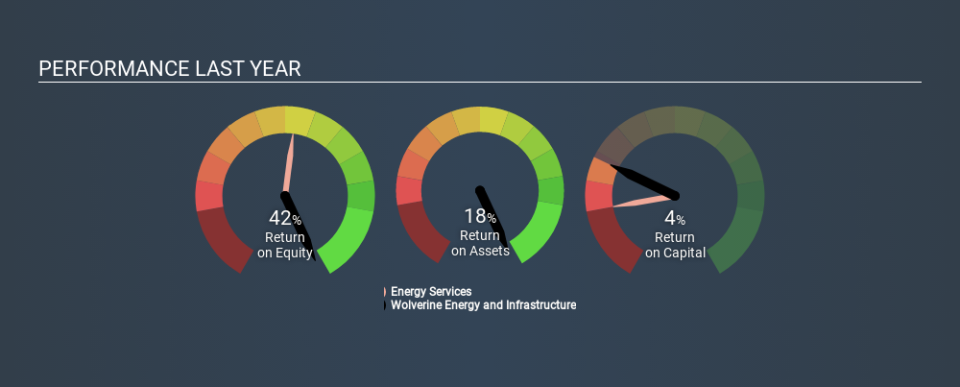Wolverine Energy and Infrastructure Inc. (CVE:WEII) Might Not Be A Great Investment

Today we are going to look at Wolverine Energy and Infrastructure Inc. (CVE:WEII) to see whether it might be an attractive investment prospect. Specifically, we'll consider its Return On Capital Employed (ROCE), since that will give us an insight into how efficiently the business can generate profits from the capital it requires.
First up, we'll look at what ROCE is and how we calculate it. Then we'll compare its ROCE to similar companies. And finally, we'll look at how its current liabilities are impacting its ROCE.
Return On Capital Employed (ROCE): What is it?
ROCE is a measure of a company's yearly pre-tax profit (its return), relative to the capital employed in the business. In general, businesses with a higher ROCE are usually better quality. In brief, it is a useful tool, but it is not without drawbacks. Author Edwin Whiting says to be careful when comparing the ROCE of different businesses, since 'No two businesses are exactly alike.
How Do You Calculate Return On Capital Employed?
Analysts use this formula to calculate return on capital employed:
Return on Capital Employed = Earnings Before Interest and Tax (EBIT) ÷ (Total Assets - Current Liabilities)
Or for Wolverine Energy and Infrastructure:
0.043 = CA$8.2m ÷ (CA$264m - CA$72m) (Based on the trailing twelve months to December 2019.)
Therefore, Wolverine Energy and Infrastructure has an ROCE of 4.3%.
View our latest analysis for Wolverine Energy and Infrastructure
Does Wolverine Energy and Infrastructure Have A Good ROCE?
ROCE can be useful when making comparisons, such as between similar companies. We can see Wolverine Energy and Infrastructure's ROCE is meaningfully below the Energy Services industry average of 14%. This performance is not ideal, as it suggests the company may not be deploying its capital as effectively as some competitors. Independently of how Wolverine Energy and Infrastructure compares to its industry, its ROCE in absolute terms is low; especially compared to the ~1.7% available in government bonds. There are potentially more appealing investments elsewhere.
You can see in the image below how Wolverine Energy and Infrastructure's ROCE compares to its industry. Click to see more on past growth.
When considering ROCE, bear in mind that it reflects the past and does not necessarily predict the future. Companies in cyclical industries can be difficult to understand using ROCE, as returns typically look high during boom times, and low during busts. ROCE is only a point-in-time measure. Remember that most companies like Wolverine Energy and Infrastructure are cyclical businesses. Future performance is what matters, and you can see analyst predictions in our free report on analyst forecasts for the company.
How Wolverine Energy and Infrastructure's Current Liabilities Impact Its ROCE
Current liabilities are short term bills and invoices that need to be paid in 12 months or less. The ROCE equation subtracts current liabilities from capital employed, so a company with a lot of current liabilities appears to have less capital employed, and a higher ROCE than otherwise. To check the impact of this, we calculate if a company has high current liabilities relative to its total assets.
Wolverine Energy and Infrastructure has current liabilities of CA$72m and total assets of CA$264m. As a result, its current liabilities are equal to approximately 27% of its total assets. This is not a high level of current liabilities, which would not boost the ROCE by much.
Our Take On Wolverine Energy and Infrastructure's ROCE
That's not a bad thing, however Wolverine Energy and Infrastructure has a weak ROCE and may not be an attractive investment. Of course, you might find a fantastic investment by looking at a few good candidates. So take a peek at this free list of companies with modest (or no) debt, trading on a P/E below 20.
If you are like me, then you will not want to miss this free list of growing companies that insiders are buying.
Love or hate this article? Concerned about the content? Get in touch with us directly. Alternatively, email editorial-team@simplywallst.com.
This article by Simply Wall St is general in nature. It does not constitute a recommendation to buy or sell any stock, and does not take account of your objectives, or your financial situation. We aim to bring you long-term focused analysis driven by fundamental data. Note that our analysis may not factor in the latest price-sensitive company announcements or qualitative material. Simply Wall St has no position in any stocks mentioned. Thank you for reading.



